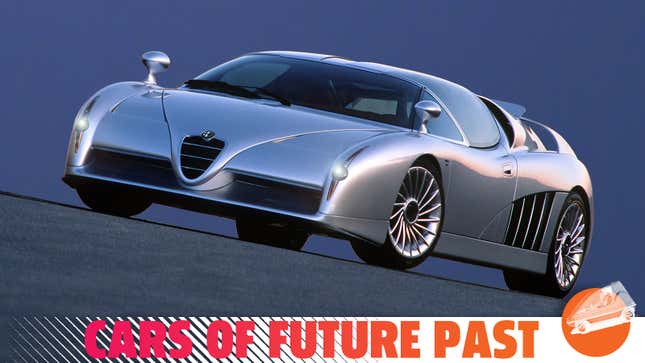
Welcome to another installment of Cars Of Future Past, a series at Jalopnik where we flip through the pages of history to explore long-forgotten concepts and how they had a hand in shaping the cars we know today.
For a brand perpetually active in motorsport with a flair for the dramatic and sporty, Alfa Romeo surprisingly shies away from the supercar thing. Long, long, long after the low-volume Tipo 33 Stradale and oddball SZ, there was the brief 8C Competizione, and the 4C, an admirable, though often-overlooked attempt at making a tossable midengine sports car “for the masses.” Every couple of years Alfa likes to tease that crown jewel you just know it wants to build, like the gorgeous Viper-based TZ3 Stradale designed by Zagato. But it doesn’t have a track record of following through.
In the late-’90s, though, Alfa very nearly did follow through, with a particularly off-beat proposition built to excel on and off the track.
What It Was

It was called the Scighera, and it was Alfa Romeo’s idea of a supercar in 1997. “Scighera” is Milanese for “mist” — a rather light and effervescent moniker for a 3,200-pound Italian brick with a three-liter, 400-horsepower twin-turbo V6 behind the driver. The Scighera was Italdesign’s contribution to the Geneva Motor Show that year, borrowing some cues from the design house’s own Nazca C2 concept for BMW from earlier in the decade.
Like the Nazca, the Scighera struck a somewhat unconventional profile for a supercar, but even more dramatically so. It got progressively taller and bulkier behind the canopy, carving an almost breadvan-like shape. The movable art deco-esque side intakes and delicate “clown-eye” headlights gave it a more elegant, luxurious vibe missing from other Italian exotics of the day.
The Scighera was a weird car, with its spindly, turbine-like rims, decoy, swept-back A-pillar and an interior clad with so much ornate Connolly leather, it would have embarrassed Silver Spur owners. Just look at those belts over the door card!
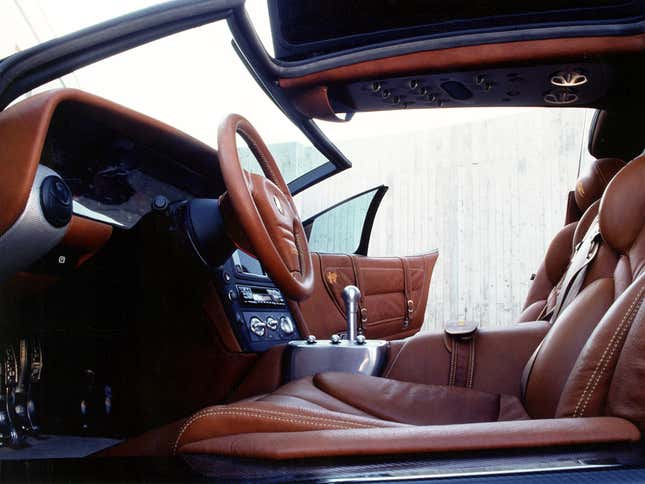
It was also surprisingly functional for a concept. While the Scighera’s doors opened conventionally, its side windows opened upward in a gullwing style. Although that wouldn’t seem to make a ton of sense in practice, it does look breathtaking with all the panels exploded, and teased that the glass could be removed entirely, transforming the Scighera into a stylish T-top.

Still, the concept’s most striking angle was the rear quarter. The back window met the top of the integrated pseudo-spoiler that also served as a huge, curvy lightbar. That strip fed into two oblong, vertical taillights at the absolute fringes of the mass. Nowadays these elements would probably all be connected into one, unbroken upside-down red boomerang, but the effect is still pretty striking by modern standards. It almost reminds me of the Maserati 3200GT’s original taillight design, before that Italian automaker chickened out and replaced it with something infinitely more boring with the Coupé midcycle refresh.
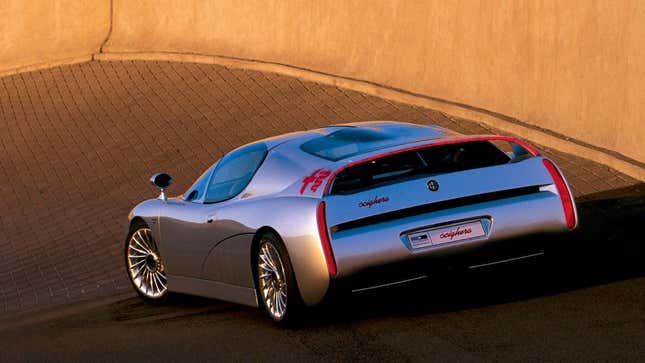
The Scighera’s weird, concave rear design also concealed a neat, hidden trick. Within that molded “spoiler” mostly connected to the rest of the body is an actual flap that deploys at speed. This flap was painted crimson underneath, a cue reminiscent of the Mitsubishi HSR-II’s motif of accentuating its myriad aero devices with copious amounts of red.
Why It Matters
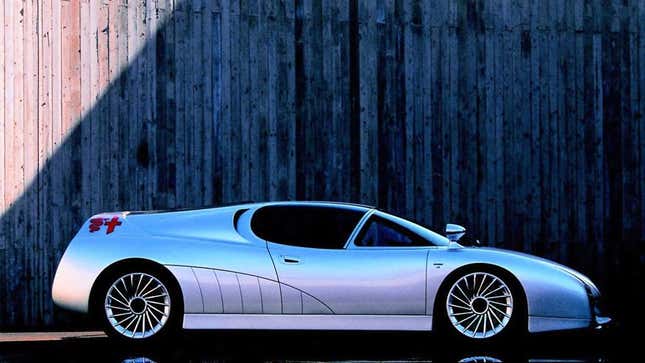
Reading up on so many one-offs for Cars Of Future Past, I’ve developed an appreciation for prototypes that aren’t merely design studies and museum pieces, but honest proofs-of-concept. That’s exactly what the Scighera was. I suspect its looks won’t appeal to everyone — I get it, it took a long time to grow on me, too — but its delicate exterior conceals purpose-built, driver’s car running gear underneath.
The Scighera had that twin-turbo V6, as I mentioned earlier. But that motor sent power to all four corners, borrowing the all-wheel drive system out of the 155 sedan. The frame was based on the 164's, only comprised of aluminum and carbon-fiber components, and the body was fashioned entirely from aluminum, too.
Alfa had bigger dreams for the Scighera than sitting idly along the marina in Monaco. Positioned right next to the silver concept at the very same Geneva Motor Show in 1997 was another Scighera. This example was red, with lots of decals, a monster rear wing and lovely white-painted Cromodora wheels. It was a race car, and it would have looked right at home on the Mulsanne.
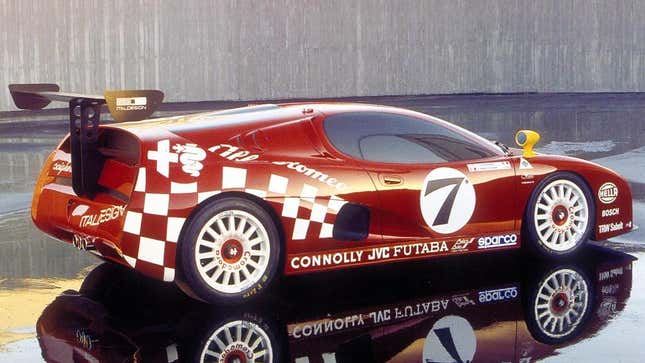
The Scighera GT is even more forgotten today than the roadgoing concept, probably because it never actually competed and also doesn’t appear to have an interior — indicating that there may not have been any machinery underneath the body. Nevertheless, in another universe the Scighera GT is just another reason why fans miss the golden era of late-’90s sports car racing, mentioned in the same breaths as the McLaren F1 GTR, Porsche 911 GT2 Evo, and Ferrari F40 LM.
What Happened To It
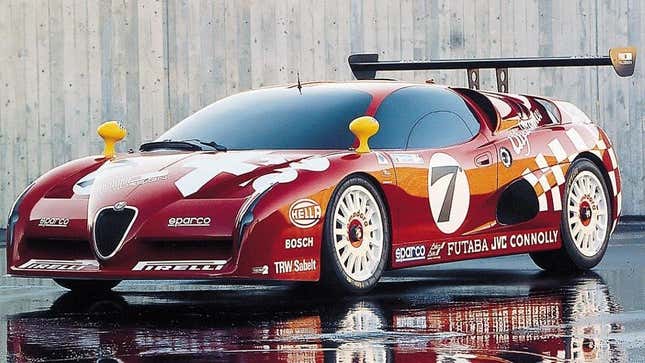
Nothing. The Scighera went nowhere, despite rumblings at the time that Italdesign was considering a limited-production run, possibly to at least serve as homologation for a racing program. Alfa Romeo wouldn’t have its flagship supercar until the 8C emerged as a concept in 2003, followed by a production version in 2006 limited to 500 units. Unlike the Scighera, Alfa had no racing ambitions for that coupe. Probably for the best, considering the horror stories about how awful the 8C was to drive.
What Games You Can Drive It In
There is only one game that includes the Scighera, though it’s a biggie: Need For Speed III: Hot Pursuit.
In the game it’s called an Italdesign Scighera, sort of how the Lamborghini Cala was attributed to Italdesign in Need For Speed II. It’s not the only vehicle from Giorgetto Giugiaro’s studio featured in NFS III, because the Nazca C2 also made an appearance.
NFS’ car rosters around this time were limited, yet extremely inspired. Perhaps it’s just reflective of how exciting concepts and automotive design in general were leading up to the millennium, but Electronic Arts had a discerning eye when sourcing its selections. That was enhanced by the Showcase mode, a staple of these early NFS titles that offered an innovative and educational way to explore every vehicle, that really put the multimedia capabilities of CD-ROMs to good use. Hearing cars like the Scighera and Mercedes-Benz CLK GTR spoken about by NFS’ immortal announcer, they end up sounding less like sports cars and more like heroes of legend.